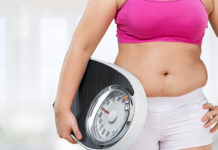So you’ve decided to start exercising and live a healthier lifestyle? Great! The first step is always a mental decision to change your habits. Along with a change in diet, exercise is the next biggest obstacle for your success in losing weight and keeping it off. Thankfully, there are many different types of exercises you can use – anywhere, anytime, any day! Best of all after a while you will start to love the feeling exercising gives you and wonder how you ever lived without it.
The options you have to pick from are limitless – whether it’s running, walking, dancing, sports or even just getting work done around the house. An important thing to note is to pick what you enjoy doing, this will lead to developing the healthier habit of daily exercise!
How much exercise should I do?
For heart health it is recommended that you do at least 30 minutes of moderate intensity exercise per day. If you are just starting out and having trouble reaching this amount, don’t worry too much as you will still be getting all the benefits.
How should I get started?
Firstly, when starting a beginner program it is recommended to consult your doctor. If you have any major health issues, or are over 45 you should definitely get medical advice before beginning just to be safe.
Next you should assess your level of fitness and set goals based on it. Are you prepared to run 3 miles? Workout at the gym three times a week? Take a walk around your neighborhood without losing breath?
It’s important you set realistic goals that you know you will be able to achieve and then alter them from there. If you set unrealistic goals you are more likely to burn out and not stick to regime, this is quite common in beginners. So the idea is to start slow and add to it as you progress so that you can develop a healthier habit for a lifetime.
Fitness terms and definitions
There are a lot of different phrases floating around amongst exercisers, and it’s hard to tell exactly what these mean. This is a list of the most common ones that you are sure to hear numerous times in your journey:
Cardio/Aerobic Exercise
Cardiovascular exercise is exercise that raises your heart rate and speeds your breathing up. This includes such activity as walking, running, dancing, biking and swimming amongst many others.
Maximum Heart Rate
This is calculated based on your age and is considered the maximum beats per minute (BPM) that your heart can reach. The formula is quite simple, you simply subtract your age from 220. For example if you’re 20 years old your maximum heart rate would be 200 BPM.
Flexibility/Stretching
This exercise is usually used to increase the flexibility you have in your joints. The older you are usually the less flexible you are, as your muscles/ligaments/tendons actually shorten over time. By stretching you can help lengthen these again and increase your range of motion. Note: Stretching should not be used to warm-up even though most people think it should. By stretching cold muscles you actually make them more prone to injury when you start your physical activity.
Strength/Resistance Training
This is the type of exercise that involves weights, resistance bands and bodyweight exercises. It is a very important part of exercising and helps to increase your strength of different muscles. Bodyweight exercises include things such as pushups and pull ups which use the weight of your own body as resistance.
Sets and Reps
This refers to the amount of times you do a given exercise. A set is the group of times you do the exercise, and a rep (repetitions) is the number of times you do the exercise per set. For example in the gym you might do a set of 5 squats, with a rep range of 10 squats per set.
Warm-up
This is an important part of exercising that involves preparing your body for the main exercises you will be doing, every time you exercise you should start with a warm-up. Usually something involving aerobic exercise is good as it gets your heart rate up which in turn helps to warm up your muscles and lubricate your joints – this means less injuries once you get into it.
Cooldown
Once you finish your exercise you want to gradually reduce the intensity, not suddenly stop while your heart is racing. This can be similar to the warm-up in that it can be an aerobic exercise, something like jogging on the treadmill while slowly progressing to walking as your heart rate and breathing begin to slow. Additionally, this is where you can add stretching and flexibility work and it is a great time to do it.
A few beginner workout ideas
So now that we’ve covered some of the terms let’s look at creating a routine that you can use. Remember it is important that you warm-up before each and every workout, and cooldown afterwards.
After the warm-up, there are three different types of exercise you are recommended to undertake. Of course you don’t have to do these all at once, but doing them consistently is a great way to increase your overall fitness level.
Cardiovascular
A good way to start out is doing some sort of aerobic activity for 30 or so minutes depending on your fitness level. This should be done four to five times a week and you will be amazed at how much easier it gets after a few weeks. The intensity of this exercise is hard to explain but you can try using the singing test method – if you are able to easily sing a song while doing this you need to up the intensity! Some exercises for this could be running, walking, dancing or anything that you enjoy that gets your heart rate up.
Strength training
This involves targeting your major muscle groups and is very effective for weight loss, because the bigger your muscles are the more calories your body burns. You should do this training twice per week and increase this as you become stronger. When starting out make sure you use a low weight and correct form – you should be aiming to do about 12 reps per set. As you get stronger you can gradually add more and more weight to these exercises. Remember not to do the same exercise for a body part two days in a row as the muscles need time to repair.
Flexibility training
This can easily be done at any point that you have some free time during your day. It should be performed around five to seven days per week and involves exercises such as static stretches. You should hold each stretch for at least 30 seconds for optimal results.
Note: When learning how to do new exercises you should ask someone with experience to show you the correct form. A personal trainer would be great if you can afford it, some will offer a few free training sessions when you first join a gym.
Equipment for home exercise
If you can’t get to the gym or want to workout at home there is a huge range of available equipment to choose from – a lot of this is useless so read the following carefully if you plan on buying anything. Some of this equipment you already have on you because you can use your own bodyweight to do a variety of exercises!
Treadmill
One of the most iconic pieces of exercise equipment and still one of the best for cardiovascular exercise. Today’s models have a variety of different options in which you can adjust the intensity and do things such as measure your heart rate. A treadmill is a great piece of equipment that will be useful forever and you should consider purchasing one if you plan to workout from home.
Free weights
Dumbbells, barbells and kettlebells are all great choices as far as strength training equipment goes. For a beginner, dumbbells are your best bet to getting started. Look for dumbbells that have adjustable weights so that you can do a variety of different exercises with them.
Exercise ball
These are fun pieces of equipment that are also useful long-term. There are a range of different bodyweight exercises you can do using an exercise ball and they are great for core strength and balance. You can even do different types of stretches using them, really the options are limitless.
Resistance bands
These are a great cheap piece of equipment that you can use for a variety of different exercises. You can also combine these with free weights to add even more resistance. They can also be used to assist you in doing bodyweight exercises such as chin-ups and pull-ups if you have trouble doing them.
Workout Videos
Sometimes you need an extra kick to keep you going and work along workout videos can be great for this. Make sure you have a good understanding of the layout of the program before purchasing so that you know if it will work for you or not.
Try This Peculiar ‘Carb-Trick’ That Melts Up To 1 Pound Each Day
”All this by Flavor-Pairing?” I asked.
I met an old friend for lunch last month and I was super impressed with how good she looked.
She said, “It’s not so much about the Flavor-Pairing, but more about how it re-awakens what the Japanese call, ‘the weight loss doubling molecule’ which signals 22-hour a day fat-burning effect in the female body.”
Even though I was skeptical, I’ve been struggling with my weight over the last few years, so I gave it a shot and watched the same video she did.
Well, it’s only a couple weeks later and you know what they say about how “you can’t transform your body overnight”…
They’re right – it actually took me 16 days to lose 22 pounds.
Now it’s my girlfriends asking ME what I’M doing differently 💅












